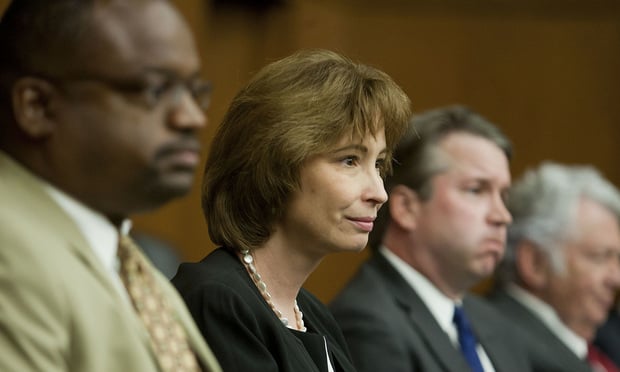But by the time of her first argument, Maynard recalled, “I was eight months pregnant and the pants no longer fit. So I had to go rent tuxedo pants for my first argument. I remember they were 40 by 40—square pants.”
Patricia Millett, now a judge on the U.S. Court of Appeals for the D.C. Circuit, recalled she was eight months pregnant at the time of her second argument as an assistant in the Solicitor General’s Office. She left the courtroom shortly before her argument time to use the restroom. The court’s security officer resisted letting her return to the courtroom until she produced something showing she was arguing the case. “He couldn’t imagine an eight-month pregnant woman sitting at the counsel table,” she said Thursday on the panel.
Millett also remembered how deputies in the SG’s office worried that during her pregnancy, the baby could arrive right before an argument. “Well, a male attorney could go out and get hit by a bus the day of an argument,” she said she told them. “Things just happen in life.”
The Solicitor General’s Office has “evolved” as more women were hired, said Sarah Harrington of Washington’s Goldstein & Russell, who recently left the solicitor’s office.
“After Deanne had her baby, there might have been a long gap by the time I had mine,” Harrington said during Thursday’s discussion, held at the National Archives and moderated by Amy Howe, co-founder of SCOTUSblog. “The culture had changed enough that moms and dads were leaving for school plays and holiday concerts.”
The three women, along with Marlene Trestman—who has researched and written about women lawyers in the Supreme Court—shared how mentors have helped guide their careers and the impact of having female justices.
Millett recalled that when she joined the D.C. Circuit, in 2013, each judge had a closet for his or her robe and in the closets were plaques naming the judges who had used the closet before them. “I begged and pleaded to get Ruth Bader Ginsburg’s closet because it meant so much to me, and I did,” she said.
Trestman noted that 729 women have made 1,448 arguments in the Supreme Court. But still, only three women were scheduled to argue in the first two weeks of the new Supreme Court term. Fewer cases and cases concentrated among the specialized Supreme Court bar are among the reasons, suggested Maynard.
“It’s hard in private practice,” said Millett, a former Akin Gump Strauss Hauer & Feld appellate partner in Washington. “You do have this very specialized bar. The three of us were assistants to the solicitor general, but when in private practice, there are only so many cases and you’re competing consistently against other people who left the Solicitor General’s Office—former solicitors general and deputy solicitors general. We had one female solicitor general for one year and she got a better job.” (That was Justice Elena Kagan.)
Clients with big cases in the Supreme Court see on the other side a former solicitor general and decide they want one too, she added. “This is the pipeline. Until women have more opportunities as deputy solicitors general, solicitors general and state solicitors general, it is hard. I found it very hard to compete for Supreme Court cases in private practice.”






